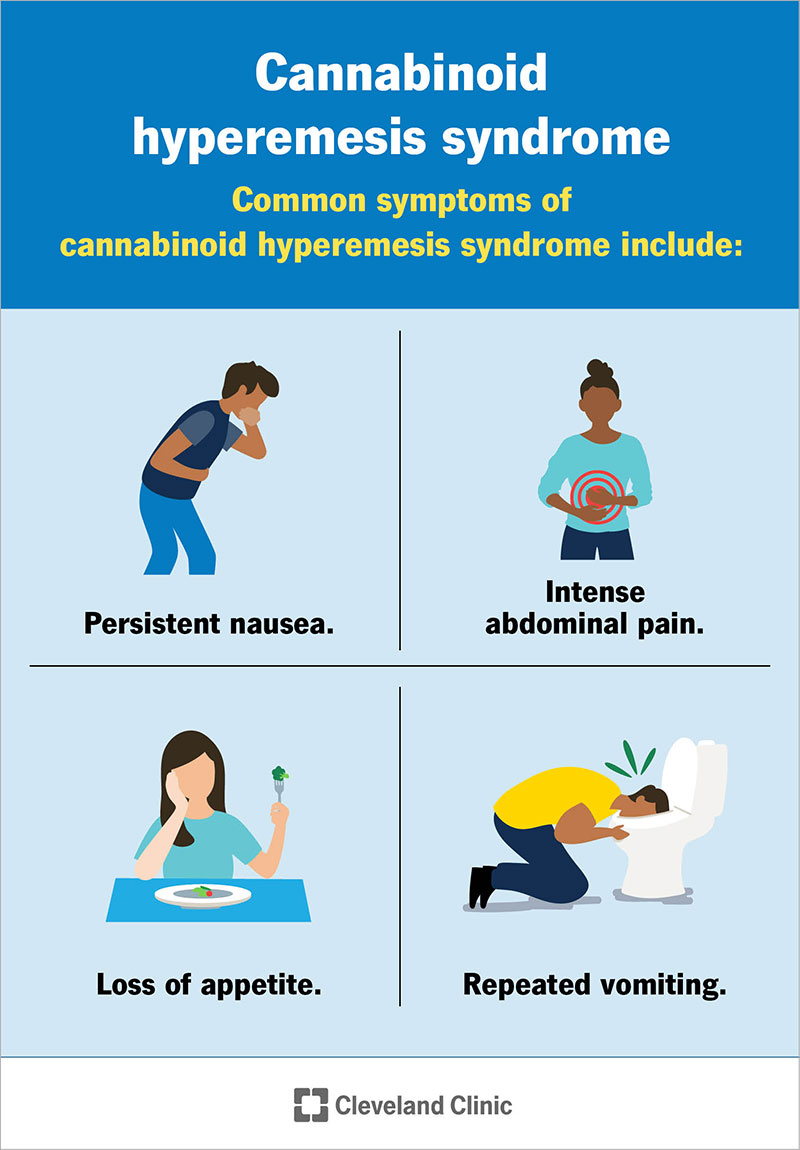Cannabinoid hyperemesis syndrome (CHS) can affect people who use cannabis (marijuana) long-term. CHS causes frequent, severe nausea and vomiting. Hot baths and showers may temporarily relieve symptoms. But the only way to cure CHS is to stop using cannabis.
Advertisement
Cleveland Clinic is a non-profit academic medical center. Advertising on our site helps support our mission. We do not endorse non-Cleveland Clinic products or services. Policy
Cannabinoid hyperemesis syndrome (CHS) happens when you have cycles of nausea, vomiting and abdominal pain after using cannabis (marijuana) for a long time. People with CHS often find temporary relief from these symptoms by taking hot baths and showers.
Advertisement
Cleveland Clinic is a non-profit academic medical center. Advertising on our site helps support our mission. We do not endorse non-Cleveland Clinic products or services. Policy
“Hyperemesis” means severe vomiting. Cannabinoids are compounds in the Cannabis sativa plant that bind to cannabinoid receptors in your brain, spinal cord, gastrointestinal tract and other body tissues. Examples of cannabinoids include tetrahydrocannabinol (THC) and cannabidiol (CBD).
CHS is more than just a side effect of marijuana use. It’s a condition that can lead to serious health complications if you don’t get treatment for it.
It’s difficult for researchers to know how common CHS is. Not everyone with the condition seeks medical help or tells their provider that they use marijuana.
One study found that 32.9% of self-reported frequent marijuana users who came to an emergency department for care met the criteria for CHS. With the widespread use, increased potency and legalization of marijuana in multiple states in the U.S., CHS may be becoming increasingly common.

Symptoms of CHS typically come on several years after the start of chronic marijuana use. But not everyone who uses marijuana long-term experiences CHS.
Common symptoms of cannabinoid hyperemesis syndrome include:
Advertisement
Hot baths and showers tend to help reduce or curb the symptoms. Many people with CHS will compulsively shower or bathe — often for hours every day — to relieve CHS symptoms.
Symptoms of CHS and their severity depend on the phase of the syndrome:
Some people call certain symptoms of CHS “scromiting.” The term combines “vomiting” and “screaming.” You may have intense pain, which causes you to scream while you vomit.
Scientists don’t yet know the exact cause of CHS. But the main theory is that it may happen due to long-term overstimulation of receptors in your endocannabinoid system (ECS). This may lead to issues with your body’s natural control of nausea and vomiting.
People who use marijuana long-term — typically for about 10 to 12 years — are at risk of developing CHS. But not every person who uses marijuana, even long-term use, develops CHS.
It tends to affect people who use cannabis at least once a week and happens more often in adults who’ve been using cannabis since their adolescent years.
Healthcare providers mainly diagnose CHS based on your symptoms, medical history and history of substance use. Your provider will do a physical exam and may ask you:
It’s important to be honest about your marijuana use if you have symptoms of CHS. Without knowing this background, providers often misdiagnose CHS as other conditions, like cyclic vomiting syndrome (CVS).
Providers typically use the following criteria to diagnose CHS:
Advertisement
Your provider may recommend certain tests to rule out other causes of nausea and vomiting, like:
The only known treatment to permanently get rid of CHS is to stop cannabis use completely. You may have symptoms and side effects of CHS for a few weeks after quitting cannabis. Over time, symptoms will disappear.
If you have cannabis use disorder and need help quitting, professional treatment is available. Talk to your healthcare provider or an addiction counselor.
Researchers are currently studying several treatment options to manage the hyperemetic phase of CHS. But there are currently no therapies approved by the U.S. Food and Drug Administration (FDA) for CHS.
You may need to go to the hospital for severe CHS. There, healthcare providers may give you:
The only cure for CHS is to stop using cannabis. Hot baths may relieve the nausea for a while, but they don’t cure CHS. Taking too many hot baths can increase dehydration due to sweating.
Advertisement
You may use home treatments to relieve CHS symptoms immediately after quitting cannabis. These remedies may help you feel better while you transition to the recovery phase. Your healthcare provider may recommend:
Most people with CHS who stop using cannabis have relief from symptoms within 10 days. But it may take a few months to feel fully recovered.
There are several possible complications of CHS, including:
CHS can increase your risk for severe dehydration. Call 911 or go to your nearest emergency room if you have any dehydration symptoms, including:
Advertisement
The only proven way to prevent cannabis hyperemesis syndrome is to avoid cannabis (marijuana).
Quitting marijuana use can be hard. If you need help quitting, speak to a healthcare provider or connect with your local addiction treatment services.
You can also call the Substance Abuse and Mental Health Services Administration (SAMHSA) National Helpline at 1.800.662.4357. It’s a free, confidential service that’s open 24/7, 365 days a year. They provide treatment referrals and information in English and Spanish.
Cannabinoid hyperemesis syndrome (CHS) is a very unpleasant — and potentially dangerous — complication of long-term marijuana use. Because of this possible complication, it’s important to use caution with marijuana and other cannabis products. If you think you have CHS or cannabis use disorder, talk to a healthcare provider. They’re available to help.
Need care fast? Cleveland Clinic’s Express Care and Urgent Care locations treat everything from sprains to sinus infections — no appointment needed.

Last reviewed on 01/16/2024.
Learn more about the Health Library and our editorial process.